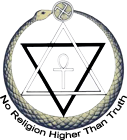The Three Hypostases
Studies in the Secret Doctrine
(Part 15 of 25)
Theosophy Magazine
Vol. 12, No. 7 May 1924
(pages 304-307)
Just as milliards of bright sparks dance on the waters of an ocean above which one and the same moon is shining, so our evanescent personalities — the illusive envelopes of the immortal MONAD-EGO — twinkle and dance on the waves of Maya. They last and appear, as the thousands of sparks produced by the moon-beams, only so long as the Queen of the Night radiates her lustre on the running waters of life: the period of a Manvantara; and then they disappear, the beams — symbols of our eternal Spiritual Egos — alone surviving, re-merged in, and being, as they were before, one with the Mother-Source. (The Secret Doctrine I, 237.)
THUS are imaged for us the three Hypostases or Avasthas of the One Life. Whether we study the Three Fundamentals of The Secret Doctrine in a universal or an individual sense, as seemingly separate entities in manifestation or in their static condition of perfect equilibrium in pralaya, it is necessary for us to decipher the three factors involved therein.
The first Fundamental deals with the Principle which is the One Life undivided and indivisible. The second treats of Its manifestation — the appearance and disappearance of the reflection which It casts and which we call the universe in cosmology and man in anthropology. The third asserts the identity of nature between the One Life and the Universe — Man, between the rays and the Luminary and, in doing so, logically takes notice of the reflections cast on the waters of space by the innumerable beams which emanate from the Universal Man — Maha-Purusha or Narayana, the Container of all men, Naras. In other words: Each human being is an incarnation or manifestation of Deity. It is said — so many men on earth, so many gods in heaven; and yet these gods are in reality One, like the rays of the moon, they are withdrawn into the parent luminary, which in its turn is merged in the One Absolute.
A proper understanding of the Three Fundamentals reveals this great fact: in his innermost nature man is the Absolute. Says The Secret Doctrine: “…the Monad or Jiva per se cannot be even called spirit: it is a ray, a breath of the ABSOLUTE, or the Absoluteness rather, …” (I, 247.) And because of this there exists for man certainty of final emancipation from the limitations of concreteness, however expansive or exalted. “…it is only the spiritual potentiality in man which can lead him to become one with the INFINITE and the ABSOLUTE” (II, 79 fn.); or “At the threshold of Paranirvana it [the Monad] reassumes its primeval Essence and becomes the Absolute once more” (I, 135).
This Absolute One Life is the Perfect Bliss of Equipoise in which lie forever concealed Motion, Space and Duration, absolute and abstract. These three project radiations — “the unconscious and spontaneous shooting forth”(1) [Footnote: 1. Transactions of the Blavatsky Lodge, 94] — which result in manifestation. Absolute Motion or Abstract Space or Boundless Time are the Unknowable. The Great Breath which is the radiation above mentioned of Absolute Motion, Matter which is that of Space, and that which joins them producing the illusion of past, present, future, named Fohat, are the knowable — though unknown to all save the emancipated beings who are called Mahatmas or Great Souls.
Thus there are four factors: (1) Absolute One Life called Be-ness and (2) Its radiation, the Great Breath, which is “Its one absolute attribute, which is ITSELF, eternal, ceaseless Motion” (I, 2); this Great Breath or Absolute Abstract Motion “is one of the three aspects of the Absolute — Abstract Space and Duration being the other two” (I, 43). Therefore we have to take cognizance of (3) Space-Matter and (4) Fohat, the bridge between Spirit and Matter, the dynamic energy which links the one to the other.
Let us apply this to the image pictured for us in the extract with which we began: There are the “milliards of bright sparks;” there is the “one and the same moon;” there are the beams “one with the Mother-Source”; and the moon in its turn is merged in the Light which is Darkness — the Absolute. The moon, the luminary is but an appearance — “the plane on the surface of the Circle” (I, 18). This circle is the plane of the sphere whose length and breadth and thickness are coeval and equal and are named as above Motion-Space-Duration.
It is the same truth which Sri Krishna puts forth in the Seventh Discourse where he speaks of himself and his two natures, lower and higher nature, apara and para prakriti. Krishna is the Great Breath whose higher nature is Daiviprakriti or Fohat, his Light, while his lower nature is Mulaprakriti, from and in which all material manifestations take place. As the Great Breath he is the one “attribute” of the Absolute; that is why he is named Aja, Unborn. With the power of his two natures he manifests himself — “establishes this whole universe with a single portion of himself” — and in the non-manifested state “remains separate” from manifestation.
The Absolute and Its primeval triune differentiation are symbolized by the 4 or the Tetraktis for the same reason that Brahma is Chatur-mukha, four-faced. Says The Secret Doctrine (I, 18):
Hiranyagarbha, Hari, and Sankara — the three hypostases of the manifesting “Spirit of the Supreme Spirit” (by which title Prithivi — the Earth — greets Vishnu in his first Avatar) — are the purely metaphysical abstract qualities of formation, preservation, and destruction, and are the three divine Avasthas (lit. hypostases) of that which “does not perish with created things” (or Achyuta, a name of Vishnu); …
Note once again the four factors — the three Hypostases of the manifesting Spirit of the Supreme Spirit as the fourth which does not perish for it never is born — achyuta and aja, imperishable and unborn.
We are now to view the processes of will, thought and action from the three angles of the personal, individual, and universal self or atma, in accordance with the law of correspondence and the law of analogy; and it is necessary to remind ourselves of the fact that there exist grave complexities of classification and division of human principles, a thorough exposition of which is beyond the scope of these studies. Therefore, what is said is but an analogical indication and no more.
Let us then see this four-foldness in ourselves. We are triune; in our personal aspect we are the reflections, the milliards of bright sparks; they are produced by the Manas-Ego, which is our second aspect, that of individuality; this Manas-Ego is a ray from the Parent Sun which is our Monadic aspect as Atma-Buddhi; beyond the last named is Atma, universal, the Light which by a transcendental process inherent in its own self-nature, svabhava, comes to a focal point called the Sun. Sun, Ray, Reflection, are the three Hypostases of the manifesting Light, which is Darkness. Or we can notice them in the processes of our lower personal self: Memory is the moon whose beam is the thirst for life, tanha, which begets the reflection called the body, but behind the body, desire and memory is the “I” — the ahankara which is the womb of the three. Body, Desire, and Memory are the three Hypostases of the manifesting “I” which is present in them all perpetually. The universal “I,” the individual “I,” the personal “I,” are the three Hypostases of that Absolute Life which is the SELF.
There is another way in which these three Hypostases or Avasthas have to be studied: the formative or creative, the preservative or sustaining, and the destructive or regenerative aspects of the One Life. Consciousness manifests as a triple process — by the power of action (Kriya) it creates, by that of Love-Wisdom (Gnyan) it preserves, and by that of Will (Ichcha) it regenerates. Therefore in the Hindu Pantheon the universal manifester Brahma is the creator, the universal preserver Vishnu, the Mighty Lover, the universal regenerator Shiva, the Destroyer. Within us as personal-ahankaric beings, or as individual-atmic beings, or as universal parmatmic beings, is the triple process of Will, Thought, and Action, material, psychical, and spiritual.
Because consciousness is triple the path to perfection is threefold: of Karma which deals with the Kriya-action aspect; of Gnynan which deals with the thought aspect; of Bhakti which deals with the will aspect. By Karma we create, by knowledge we preserve, by devotion we regenerate. Karma begets Tamas — inertia, which knowledge sustains as Rajas — mobility, and which devotion transforms into Sattva — harmony. Sattva is Existence — Sat, which Knowledge recognizes through Ideation — Chit, and which devotion realizes in immortal Bliss — Ananda.
Within us as without us matter, force, spirit, are but the triple hypostases of the fourth, the One Life. The material manifestation of the One Life is self-ish-ness, its psychical manifestation is self-hood-ness, and its spiritual is self-less-ness — the fourth is the common factor of the three, Self-ness or Be-ness. Therefore, says The Secret Doctrine (I, 276):
…by paralyzing his lower personality, and arriving thereby at the full knowledge of the non-separateness of his higher SELF from the One Absolute SELF, man can, even during his terrestrial life, become as “One of Us.”
The practical, which is the ethical, application for this mighty achievement is to be found in The Voice of the Silence in the teaching about the three Halls, the three states through which the aspirant passes — “beyond which stretch the shoreless waters of AKSHARA” — the Absolute. These halls correspond to the Jagrat, Svapna and Sushupti states of consciousness — beyond which is Turiya.
But for the ahankaric-I there would be no memory, no thirst for separate life and no body; but for the Turiya state, we would not have the refreshment of deep sleep, or the disturbance of dreams, or the waking life; from the Fount of Omniscience spring Wisdom and Learning and Ignorance as from Akshara-Letter, come Shabda-Word, Shloka-Verse and Katha-Narrative; and finally, but for the Absolute there would be neither the Monadic, Egoic or Personal existence — the Eternal, the Divine, and the lower Self. Says The Voice of the Silence:
Restrain by thy Divine thy lower Self.
Restrain by the Eternal the Divine.
Back to Studies in the Secret Doctrine

